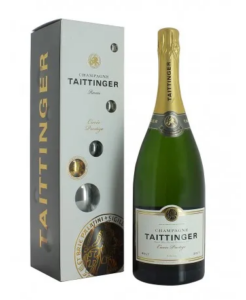Taittinger is my mother in law’s favourite champ. It is her go to for all occasions that need to be appropriately fêted. I love that Grace Kelly was their spokesperson and they did indeed have a brilliant marketing campaign.
I have written about the Tattinger demi-sec and adore Domaine Caneros–their sparkling house in Napa Valley that is fashioned after a French chateau–amour! I will not be addressing either of these here, but specifically reporting about their Brut.

There is no question that Tattinger Brut is good. The bigger question here is how does it compare to other bottles in a similar price point? The only true way that this can be decided is by a blind tasting which we will definitely do at some point again this year and will surely include the Germ’s mother who is such a fan.
The bottle that we had was yummy–but it was lacking. One glass into it, I became quickly snuffed up. This is a relatively new phenomena that I have inherited from my mother and is the result of a mild sulpha allergy which is getting worse. Growing up, I recall my mother becoming extremely congested, often with red wines, but the bottom line was the congestion was the result of sulphites present in the bottle. Sulphites in champ? It didn’t cross my mind. I checked the back label of the bottle and there it was. The disclaimer–this bottle contains sulphites. Since we always have many bottles of champagne on hand, I checked a few others. Surprsingly, Taittinger was not the only bottle to contain sulphites. Since I haven’t had this reaction from many other bottles of champ, I am going to be on the watch, trying other bottles that do contain sulphites and see if the reaction (which I will say is quite a sniffly unpleasant mess) continues.
Founded in 1734, the Taittinger Champagne house is based in Reims. The flagship wines of the house are the Comtes de Champagne (composed of 100% Chardonnay) and Comtes de Champagne Rosé (1
Champagne Taittinger was established in 1931 by Pierre Taittinger on the foundations of Forest-Forneaux, itself established in 1734 and the third-oldest wine producing house of Champagne. Taittinger is today proprietor of approximately 600 acres of vines among which are included parcels in the one hundred – percent rated villages of Cramant and Avize in the Cote des Blancs; and Bouzy, Mailly, Ambonnay and Verzenay in the Montagne de Reims. The Taittinger Estate is one of the three most extensive in the Champagne district, and the firm’s major holdings in Chardonnay vineyards are the physical expression of the Taittinger philosophy and style.Medium straw color, with an impressive mousse and a fine, active bead; plenty of yeasty bread dough on the nose, which, with a good dose of minerality, takes on a supporting role to the rich under-ripe apple in the flavor profile. Plenty of froth in the mouth, zippy acidity, good intensity and nice length on the finish. Solid, straightforward Champagne, making no pretension to be anything more than it is, and quite enjoyable for all that; frankly, I could drink this two or three times a week.
That being said, we finished the bottle–snuffed up be damned.
